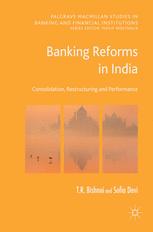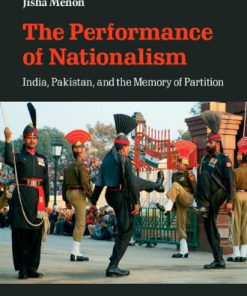Banking Reforms in India Consolidation Restructuring and Performance 1st Edition Bishnoi, Sofia Devi ISBN 3319556630 9783319556635
$50.00 Original price was: $50.00.$25.00Current price is: $25.00.
Banking Reforms in India: Consolidation, Restructuring and Performance 1st Edition T R Bishnoi, Sofia Devi – Ebook PDF Instant Download/Delivery: 3319556630, 978-3319556635
Full download Banking Reforms in India: Consolidation, Restructuring and Performance 1st Edition after payment

Product details:
ISBN 10: 3319556630
ISBN 13: 978-3319556635
Author: T R Bishnoi, Sofia Devi
This book provides a historical evaluation of banking reforms and structural changes in India over the past 25 years. Chapters cover issues in consolidation and restructuring, competition and concentration, performance evaluation in terms of cost efficiency and productivity, profitability, non-performing assets and technology use. The authors use specific regression models to measure the impact of these reforms on bank performance during this period and assess whether or not the consolidation phase is now complete. This volume will be of interest to researchers and academicians interested in the financial history of Indian Banking reforms.
Banking Reforms in India: Consolidation, Restructuring and Performance 1st Table of contents:
1. Indian Banking Structure: An Overview
- Introduction: Overview of the Indian banking system.
- Historical Background: The evolution of banking in India.
- Regulation and Optimal Banking Structure: Analysis of the regulatory framework and what constitutes an optimal banking structure.
- Banking Structure After Financial Reforms: Impact of financial reforms on the banking landscape.
- Narasimham Committee on Financial Reforms: Discussion on the Narasimham Committee’s role in shaping reforms.
- Relative Size of Banking: Comparative size and scale of banks in India.
- Accessibility and Outreach: Examination of how accessible banking services are across India.
- Allocation of Credit: How credit is distributed across sectors.
- Restructuring and Consolidation: Conceptual understanding of restructuring and consolidation in banking.
- Conclusion: Summary of insights.
2. Banking Reforms
- Deregulation: Effects of deregulating the banking sector.
- Liberalizing Entry Barriers and Interest Rates: Analysis of the liberalization of entry restrictions and interest rates.
- Variable Reserve Ratios: The role of reserve ratios in banking stability.
- Banking Prudential Regulations: Focus on risk management and solvency.
- Capital to Risk-Weighted Asset Ratio: Regulatory capital requirements.
- Governance and Transparency: Importance of good governance and transparency in banking.
- Non-performing Assets (NPAs): Approaches to handling bad debts.
- Legal Approach to Asset Recovery: Legal tools for recovering non-performing assets.
- Conclusion: Recap of banking reforms.
3. Restructuring and Consolidation—Mergers and Acquisitions
- Theory, Objectives, and Empirical Evidence: Exploration of mergers and acquisitions in banking.
- Regulatory Framework: Legal and regulatory environment of mergers and acquisitions.
- Pre- and Post-merger Performance: Case studies of banks involved in mergers (e.g., Bank of Baroda, HDFC Bank, ICICI Bank, etc.).
- Performance Ratios: Analysis of profitability, solvency, and other financial metrics post-merger.
- Conclusion: Insights on restructuring and consolidation.
4. Concentration and Competition
- Empirical Studies: Research on market concentration and competition in banking.
- Methodological Approaches: Techniques used to assess market concentration, including the Herfindahl-Hirschman Index and the Panzar-Rosse model.
- Competition Analysis: Examining both price and non-price competition in the banking sector.
- Conclusion: Summary of findings.
5. Cost Efficiency and Productivity
- Empirical Studies: Review of studies on cost efficiency and productivity in banks.
- Cost Analysis: Study of average and marginal costs, economies of scale, and sources of diseconomies.
- Productivity: Exploration of productivity in the banking sector, including manpower productivity.
- Conclusion: Discussion on efficiency and productivity improvements.
6. Profitability
- Profitability Analysis: Study of the factors affecting profitability in banks.
- Operating Income and Expenditure Structure: Breakdown of income and expenses.
- Determinants of Profitability: What drives profitability in banks.
- Conclusion: Summary of profitability trends.
7. Non-performing Assets
- Theory and Impact: The causes and effects of non-performing assets (NPAs).
- Macroeconomic Factors: The role of the economy in influencing NPAs.
- Asset Classification: How NPAs are classified and managed.
- Trends: NPAs at the global level and within Indian banks.
- Sector-wise NPA Distribution: Analysis of NPAs across different sectors.
- Conclusion: Insights into NPA management.
8. Information Technology in the Banking System
- Role of IT: The impact of information technology on banking operations and performance.
- Technology in Payment Systems: How technology is transforming payment systems.
- IT Use and Bank Performance: Correlation between the use of IT and banking performance.
- Conclusion: The future of technology in banking.
9. Summary and Conclusions
- Banking Structure: Summary of the banking structure in India.
- Banking Reforms: Overview of banking reforms.
- Consolidation and Restructuring: Recap of the trends in bank consolidation and restructuring.
- Concentration and Competition: A summary of market concentration and competition findings.
- Performance: Overview of banking performance.
- Policy Suggestions: Recommendations for improving the banking sector.
People also search for Banking Reforms in India: Consolidation, Restructuring and Performance 1st:
father of banking reforms in india
recent banking reforms in india
committees on banking reforms in india upsc
major banking reforms in india
latest banking reforms in india
Tags:
Bishnoi,Sofia Devi,Banking,Reforms,India,Consolidation, estructuring,Performance 1st
You may also like…
Fiction
The Performance of Nationalism India Pakistan and the Memory of Partition 1st Edition Jisha Menon
Business & Economics
Co operative Banking Networks in Europe Models and Performance Federica Poli
Mathematics
Ethnobotany of India Volume 5 The Indo Gangetic Region and Central India 1st Edition T. Pullaiah
Education Studies & Teaching
Cookbooks
Politics & Philosophy - Government & Politics












